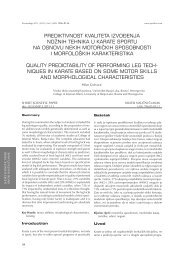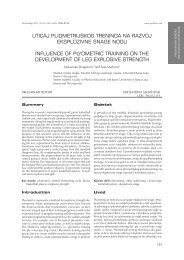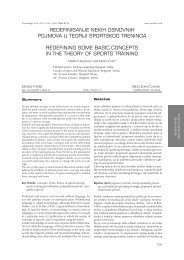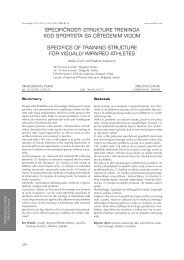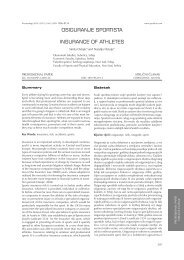istorijski razvoj metoda za praÄenje maksimalne potroÅ¡nje kiseonika ...
istorijski razvoj metoda za praÄenje maksimalne potroÅ¡nje kiseonika ...
istorijski razvoj metoda za praÄenje maksimalne potroÅ¡nje kiseonika ...
You also want an ePaper? Increase the reach of your titles
YUMPU automatically turns print PDFs into web optimized ePapers that Google loves.
Stojiljković, N., Radovanović, D., & Savić, Z.: HISTORICAL DEVELOPMENT OF METHODS... Proceedings 2010, 143-151speeds. They then presented to the scientific community, theterm “maximal oxygen consumption“. The above authors alsonoted that the maximum values of oxygen consumption aredifferent for different subjects. They also identified the mostimportant links in the system of oxygen transport, which incorporatedclosely related functions of the respiratory, circulatoryand skeletal-muscular system. The concept of maximal oxygenuptake was used as base in the application of physical exercise,which made it difficult to understand the basic physiologicalterms.Methodstada naučnoj javnosti predstavili termin „maksimalna potro{nja<strong>kiseonika</strong>“. Navedeni autori su takođe istakli da se <strong>maksimalne</strong>vrednosti potro{nje <strong>kiseonika</strong> razlikuju kod različitihispitanika. Takođe su identifikovali najvažnije veze u sistemutransporta <strong>kiseonika</strong>, koji je inkorporirao tesno pove<strong>za</strong>nefunkcije respiratornog, cirkulatornog i skeletno-mi{ićnogsistema. Koncept <strong>maksimalne</strong> potro{nje <strong>kiseonika</strong> predstavljaoje osnovu u primeni fizičkog vežbanja koje je otežavalorazumevanje osnovnih fiziolo{kih odredbi.Metode istraživanjaREVIEW PAPERPREGLEDNI ČLANAKThis is review article and accordingly with that we have useddescriptive method or observations. In order to make betterretrospective of methods for monitoring of maximal oxygenconsumption a large number of scientific papers, articles andmonographs in which is presented a method for measuringmaximal oxygen uptake were collected. Analyzed scientificpapers were collected via internet by searching electronic editionsof scientific journals in the scientific databases (ProQuest,EBSCO, High Wire, Free Medical, HINARI and Ovid). Duringthe research the following keywords were used: maximal oxygenconsumption, endurance training, and diagnosis of athletes.After the collection of scientific papers the classification wascarried out. The study focused on the oldest works that mentionthe concept of maximal oxygen uptake, which were paperspublished in the second half of the nineteenth and early twentiethcentury. Then an analysis of the collected works wascarried out.DiscussionThe ability to study oxygen transport system during physicalexercise depended on many fundamental research. It allstarted with Joseph Pristley (1733-1804), English scholar,theologian, clerks dissident, teacher and educator which isconsidered one of the greatest merits attributed to isolateoxygen, even though the same merits attributed to CarlWilhelm Scheele (1742-1786), Swedish scientist, who isindependently of Pristley conducted their research and alsoseparated from the air a substance that would later be called“fireair” (Scheele, 1894). The right explanation and meaningof their findings gave one Frenchman, Antoine Lavoisier(Antoine Laurent de Lavoisier, 1743-1794). In 1777 Lavoisierwas wrote “respiration is nothing but a slow combustionof carbon and hydrogen, in all respects like burning lampsor candles, so that from this point to say that living beingswho breathe flammable materials which burn and consumethemselves” (Lavoisier, 1777 ). At that time, Lavoisier wasunable to clearly define the process of breathing. Lavoisierwas the first who attempted to measure gas exchange duringbreathing, and not only at rest but during exercise. The resultsof his measurements have been published in scientific memoirsin 1789 (Memoire de Science), and as a co-author onthe paper found his colleague, the French scientist and industrialistArmand-Jean-François Seguin (Seguin & Lavoisier,1789). Thanks to the drawing which is presented in detailthe conduction of this experiment and is drawn by AntoineLavoisier’s wife, Mary Anna Lavoisier, the published textabout performing this experiment is much clearer. Face maskwas applied to measure not only the exhaled carbon dioxide(CO 2), but also to monitor the consumption of oxygen (O 2).During the experiment subject raised foot pedal, and thework has been estimated from the number of lifts of theOvaj rad predstavlja pregledno istraživanje pa je u skladu satim u radu kori{ćena deskriptivna <strong>metoda</strong> odnosno opservacija.Kako bi se napravila {to kvalitetnija retrospektiva<strong>metoda</strong> <strong>za</strong> prećenje makimalne potro{nje <strong>kiseonika</strong> prikupljenje veliki broj naučnih radova, tekstova i monografija u kojimaje predstavljen metod <strong>za</strong> merenje <strong>maksimalne</strong> potrošnje<strong>kiseonika</strong>. Naučni radovi koji su analizirani prikupljeni supreko interneta pretraživanjem elektronskih izdanja naučnihčasopisa u ba<strong>za</strong>ma ProQuest, EBSCO, High Wire, FreeMedical, Hinari i Ovid. Prilikom pretrage kori{ćene su sledećeključne reči maksimalna potro{nja <strong>kiseonika</strong>, trening izdržljivosti,dijagnosticiranje sportista. Nakon obavljenog prikupljanjaradova izvr{ena je klasifikacija istih. Istraživanje jebilo fokusirano na najstarije radove u kojima se pominjepojam <strong>maksimalne</strong> potro{nje <strong>kiseonika</strong>, a to su bili radoviobjavljeni u drugoj polovini XIX i prvoj polovini XX veka.Nakon toga izvr{ena je anali<strong>za</strong> prikupljenih radova.DiskusijaMogućnost da se izučava transportni sistem <strong>kiseonika</strong> u tokufizičkog vežbanja <strong>za</strong>visio je od mnogih fundamentalnih istraživanja.Sve je počelo sa Džozefom Pristlijem (1733-1804),engleskim naučnikom, teologom, klerikanskim disidentom,učiteljem, kome se kao jedna od najvećih <strong>za</strong>sluga pripisujeizolovanje <strong>kiseonika</strong>, mada se iste <strong>za</strong>sluge pripisuju i KarluVilhemu [ilu (1742-1786), {vedskom naučniku, koji je ne<strong>za</strong>visnood Pristlija sprovodio svoja istraživanja i takođe izvazduha izdvojio supstancu koja će kasnije biti nazvana„vatreni vazduh“ (Scheele, 1894). Pravo obja{njenje i značenjenjihovog otkrića dao je 1779. godine jedan Francuz,Antoan Lavoazje (Antoine Laurent de Lavoisier, 1743-1794).Lavoazje je 1777. godine napisao „respiracija nije ni{tadrugo do sporo sagorevanje ugljenika i vodonika, po svimaspektima slično gorenju lampe ili sveće, pa se sa ove tačkegledi{ta može reći da su živa bića koja di{u <strong>za</strong>paljive materijekoje sagorevaju i tro{e sebe same“ (Lavoisier, 1777). Utom trenutku Lavoazje nije mogao jasnije da defini{e procesdisanja. Lavoazje je bio prvi koji je poku{ao da meri razmenugasova prilikom disanja i to ne samo u stanju mirovanjaveć i u toku vežbanja. Rezultati njegovog merenja bili suobjavljeni u Naučnim memoarima 1789. godine (Memoirede Science), a kao koautor na ovom radu na{ao se njegovkolega, francuski naučnik i industrijalac, Armand Sažen(Armand-Jean-François Seguin) (Seguin i Lavoisier, 1789).Zahvaljujući crtežu koji je detaljno predstavljao sprovođenjeovog eksperimenta i koji je nacrtala supruga Antoana Lavoazjea,Meri Ani Lavoazje, uz objavljen tekst mnogo je jasnijekako je ovaj eksperiment izveden. Maska <strong>za</strong> lice je bilaupotrebljena <strong>za</strong> merenje ne samo izdahnutog ugljen-dioksida(CO 2), već i <strong>za</strong> praćenje potro{nje <strong>kiseonika</strong> (O 2). Ispitanikje <strong>za</strong> vreme eksperimenta nogom podi<strong>za</strong>o pedalu, a rad je144
Stojiljković, N., Radovanović, D. i Savić, Z.: ISTORIJSKI RAZVOJ METODA... Zbornik radova 2010, 143-151weight and height. The obtained values of oxygen intake andexhaled carbon dioxide were not accurate, but, as notedlater by Benedict and Cathart “results obtained by Lavoisierare not in line with results that were later obtained by modernexperimental techniques, but this in no way be reducedovershadow the importance and brilliance of the concept ofAntoine Lavoisier research” (Benedict & Cathcart, 1913).From research of Lavoisier at the end of the eighteenth century,the understanding of human limits in the performanceof physical activity were intrigued many scientists, both thosefacing the basic sciences and those who were more engagedin applying science in practice. However, to be conductedthe first qualitative study of gas exchange in humans, technicalprogress was necessary and finding of Tissot spirometry,Douglas bags for gas collection, Haldanes absorption method(John Scott Haldane was Scottish physiologist, 1860-1936) formeasuring carbon dioxide and oxygen apparatus and methodswhich were created at the beginning of twenty century (Douglas& Haldane, 1912; Haldane, 1897; Tissot, 1904).This means that 140 years after the Lavoisier’s discovery ofoxygen was established the basis for Archibald Vivian Hill tomeasure oxygen consumption, and to clarify the significanceof such measurements, and its maximum value. After Hill’sresearches, determine of the maximum oxygen consumptionhas become a generally accepted method for assessment ofcardiovascular fitness on healthy person and on persons withsome disease. Maximal oxygen consumption is still the goldstandard of cardiorespiratory endurance and the best mark ofdifferences in aerobic capacity (Ponorac, 2005). Besides theapplied measuring of VO 2max, numerous studies have beenconducted in order to define the function of every link in thecomplex chain of oxygen transport and determine their regulationand adaptability. A large number of papers publishedin the last 50 years who study the concept of maximum oxygenconsumption and provide strong scientific evidence ofgrowing interest and increasing importance to this concept.More than 100 years after Lavoisier’s observations of respiratoryfunctions, Edward Smith began his first systematicstudy of respiratory and metabolic responses in humansduring muscle work (Chapman, 1967). He has publisheddata which provides the values of the quantity of inhaled air(inspiratory volume), frequency of breathing (respiration rate)and heart rate at rest and in different types of exercise includingswimming, rowing, walking (Smith, 1857). His researchclearly showed that the increase in work intensity was accompaniedby increasing values of heart rate, respiratoryrate and inspiratory volume. The highest values were obtainedduring the walking speed of 4.83 km/h (3mi/h) with loadsof 52.5 kg (118pounds). In this exercise intensity inspiratoryvolume was 34L min -1 , respiration rate 24 breaths perminute, and heart rate 189 beats per minute (Smith, 1858-59). He also gave the relative values of inspiratory volumein the efforts by comparison with the values of inspiratoryvolume in rest. Smith found that it is possible that the amountof air you breathe during rest for a short time increase ofseven times during physical exertion. His expression relativechanges compared to the values at rest have become agenerally accepted unit used to express the rate of metabolismduring exercise (MET = metabolic equivalent of task,1 MET = oxygen consumption at rest) (Smith, 1859).In the last decade of the nineteenth century, German, NathanZuntz made a major contribution to the physiology ofphysical exercises (Gunga, 1989). His main area of interestwere the gases in the blood. In his study of interaction betweenventilation and the cardiovascular system in thetransport of gases as intervention he commonly used condibioprocenjen na osnovu broja ponavljanja i proizvoda težinei visine. Dobijene vrednosti potro{nje <strong>kiseonika</strong> i izdahnutogugljen-dioksida nisu bile precizne, ali, kako su kasnijeistakli Benedikt i Kathart „rezultati koje je dobio Lavoazjenisu u skladu sa rezultatima koji su kasnije dobijeni modernimeksperimentalnim tehnikama, ali to ni na koji način ne možeumanjiti značaj i <strong>za</strong>seniti brilijantnost istraživačkog konceptaAntoana Lavoazjea“ (Benedict i Cathcart, 1913).Od Lavoazjeovog istraživanja krajem XVIII veka, shvatanjaljudskih limita u izvođenju fizičke aktivnosti intrigirala suveliki broj istraživača, kako onih okrenutih bazičnim naukamatako i onih koji su se vi{e bavili primenom nauke upraksi. Međutim, da bi bile sprovedene prve kvalitativnestudije razmene gasova kod čoveka, bio je neophodantehnički napredak i pronalaženje Tisoovog spirometra, Daglasovetorbe <strong>za</strong> prikupljanje gasova, Haldanovog (John ScottHaldane, {kotski fiziolog, 1860-1936) <strong>metoda</strong> apsorpcije <strong>za</strong>merenje ugljen-dioksida i <strong>kiseonika</strong>, uređaja i <strong>metoda</strong> kojisu nastali tek početkom XX veka (Douglas i Haldane, 1912;Haldane, 1897; Tissot, 1904).To znači da je tek 140 godina posle Lavoazjeovog otkrića<strong>kiseonika</strong> stvorena osnova <strong>za</strong> Arčibalda Vivijena Hila dameri potro{nju <strong>kiseonika</strong>, i da razjasni značaj jednog takvogmerenja i njegovih maksimalnih vrednosti. Posle Hila, određivanje<strong>maksimalne</strong> potro{nje <strong>kiseonika</strong> postalo jeop{teprihvaćena <strong>metoda</strong> <strong>za</strong> procenu kardiovaskularnog fitnesakako kod zdravih tako i kod bolesnih osoba. Maksimalnapotro{nja <strong>kiseonika</strong> je i danas zlatni standard kardiorespiratorneizdržljivosti (Ponorac, 2005). Sem ovogprimenjenog merenja VO 2max, sprovedene su brojne studijene bi li se definisala funkcija svake karike u složenom lancutransporta <strong>kiseonika</strong> i odredila njihova regulacija i adaptabilnost.Veliki je broj radova objavljenih u poslednjih 50godina koji izučavaju koncept <strong>maksimalne</strong> potro{nje <strong>kiseonika</strong>i koji daju čvrste naučne dokaze <strong>za</strong> rastuće interesovanjei pridavanje sve većeg značaja ovom konceptu.Posle vi{e od 100 godina nakon Lavoazjeove opservacije respiratornefukcije, Edvard Smit je <strong>za</strong>počeo svoja prva sistematskaistraživanja respiratornih i metaboličkih reakcija kod čoveka utoku mi{ićnog rada (Chapman, 1967). On je objavio podatkeu kojima daje vrednosti kvantiteta udahnutog vazduha (inspiratornivolumen), frekvenciju disanja (stopu respiracije) i srčanipuls u miru i pri različitim tipovima vežbanja uključujući plivanje,veslanje, hodanje (Smith, 1857). Njegova istraživanja sujasno poka<strong>za</strong>la da je povećanje intenziteta rada bilo praćenopovećanjem vrednosti srčane frekvencije, frekvencije disanja iinspiratornog volumena. Najvi{e vrednosti dobio je prilikomhodanja brzinom od 4,83 km/h (3mi/h) uz no{enje tereta od52,5 kg (118 pounds). Pri ovom intenzitetu vežbanja inspiratornivolumen je iznosio 34L min -1 , frekvencija disanja 24udaha u minuti, i srčana frekvencija 189 otkucaja u minuti(Smith, 1858-59). Takođe je dao i relativne vrednosti inspiratornogvolumena u toku napora koje je dobio poređenjem savrednostima inspiratornog volumena u miru. Smit je utvrdio daje moguće da se količina vazduha koju udi{emo u toku mirovanja<strong>za</strong> kratko vreme poveća sedam puta u toku fizičkog napora.Njegovo izražavanje relativne promene u odnosu navrednosti u miru postale su op{teprihvaćena jedinica koja sekoristi <strong>za</strong> izražavanje stope metabolizma u toku vežbanja (MET= metabolic equivalent of task; 1 MET = potro{nja <strong>kiseonika</strong>u miru) (Smith, 1859).U poslednjoj dekadi XIX veka, Nemac, Natan Zunc dao jeglavni doprinos <strong>razvoj</strong>u fiziologije fizičkog vežbanja (Gunga,1989). Njegovo glavno polje interesovanja bili su gasovi ukrvi. On je u svojim istraživanjima interakcije između ventilacijei kardiovaskularnog sistema u procesu transporta gasovaREVIEW PAPERPREGLEDNI ČLANAK145
Stojiljković, N., Radovanović, D., & Savić, Z.: HISTORICAL DEVELOPMENT OF METHODS... Proceedings 2010, 143-151REVIEW PAPERPREGLEDNI ČLANAKtions of hypoxia at high altitude. However, physical activitywas the second obstacle that he faced in the study of gasexchange, and therefore had to construct the first treadmillcould use in researches. Treadmill construction enabled himgood control and recurring physical activity with the properintensity of exercise (Zuntz, 1899). Zuntz conducted detailedmeasurements of energy consumption while walking andmarching (Zuntz, & Schumburg, 1901). Particularly interestingin his work was a novelty in the use of X-rays for thestudy of heart size, not only in rest but also when walkingon a treadmill (Nicolai & Zuntz, 1914). He also measuresthe energy consumption in horses who walked at differentspeeds, as well as dogs that ran on a treadmill (Zuntz 1897;Zuntz & Lehmann, 1889).Francis G. Benedict was an American biochemist who, amongother things dealt with the measurement of oxygen consumptionduring bicycle ergometer exercise at low, moderate andhigh intensity (Benedict & Cady, 1912). During his researchtraining, with professor Wilbur O. Atwater on WesleyanCollege in Connecticut, Benedict has changed his interestsin biochemistry and moved to the area of physiology. Hisdedication to physiology led to an outstanding contributionto the understanding of energy consumption at rest andduring work. His mentor, Atwater, has worked with theGerman chemists and physiologists Voigt and Rubner, andlater with Zuntz. He brought with him the latest techniquesfor the measurement of respiration and metabolism. Benedictand Atwater one time worked in Europe with the Germanscientist Voigt. Benedict has invented a highly sophisticatedcalorimeter which allowed accurate measurementof free heat energy transport and respiratory rate (Benedict,1909). He found that oxygen consumption increases progressivelywith the increasing of workload during the exercise.The highest values of oxygen consumption of 49 ml/kg/minwas taken in 32 years old cyclists who competed as a pro.In this study he did not attempt to determine whether anyof the experiments comprehended subjects reached maximaloxygen uptake (Atwater & Benedict, 1988). Another importantcontribution of his work in the field of physiology ofphysical activity was the precise measurement of “gross” and“net” efficiency when cycling, and determine the proportionof fat and carbohydrates as energy sources (Benedict &Cathcart, 1913).Goran Liljestrand studied at the Karolinska Institute, togetherwith Erik Johan Johansson, who was even 1895 suggestedthe necessity of uniting the central and peripheralmechanisms in regulating heart rate during physical exercise(Johansson, 1895). Liljestrand, together with N. Stenstromtook this research in an impressive series of studies of men.They determined the oxygen consumption while walking,jogging, swimming, rowing and cross country skiing (Liljestrand& Stenstrom, 1920; Liljestrand & Stenstrom, 1920). Theyalso measured blood pressure and cardiac output in swimmingand rowing (Liljestrand & Lindhard, 1920; Liljestrand& Lindhard, 1920). Indirectly, used the term “maximal oxygenconsumption” and show that the values of oxygenconsumption was higher in the cross-country skiing than forrunning. The question that we do not have the answer iswheather Liljestrand and Stenstrom in their measurementsreally get the maximum value in different models of exercise.August Krogh, who worked in the laboratory of ChristianBohr, explored the mechanism of oxygen transport in thepulmonary circulation and its move from the alveoli into theblood. Research that is published on the 1910 was confirmedthat even at high consumption of oxygen, it was transportedkao intervenciju najče{će koristio uslove hipoksije na velikojnadmorskoj visini. Međutim, fizička aktivnost je bila drugaprepreka sa kojom se suočio u izučavanju razmene gasova, teje stoga morao konstruisati prvi tredmil koji je mogao koristitiu svom radu. Konstruisanje tredmila omogućilo mu je dadobro kontroli{e i stalno ponavlja fizičku aktivnost uz odgovarajućeintenzitete vežbanja (Zuntz, 1899). Zunc je sproveodetaljna merenja potro{nje energije prilikom hodanja i mar{iranja(Zuntz i Schumburg, 1901). Posebno interesantno u njegovomradu predstavljala je novina u kori{ćenju H-zraka <strong>za</strong> izučavanjeveličine srca, ne samo u miru već i prilikom hodanja natredmilu (Nicolai i Zuntz, 1914). On je takođe vr{io merenjapotro{nje energije kod konja koji u hodali različitim brzinama,kao i kod pasa koji su trčali na tredmilu (Zuntz 1897; Zuntz iLehmann, 1889).Fransis G. Benedikt bio je američki biohemičar koji se poredostalog bavio i merenjem potro{nje <strong>kiseonika</strong> u toku vežbanjana bicikl ergometru malim, umerenim i velikim intenzitetom(Benedict i Cady, 1912). U toku njegovog istraživačkogobučavanja, kod profesora Vilbura O. Etvejtera na Veslejnkoledžu u Konektikatu, Benedikt je promenio svoja interesovanjai iz biohemije pre{ao u oblast fiziologije. On je,posvetiv{i se fiziologiji, dao izuzetan doprinos u razumevanjupotro{nje energije u miru i <strong>za</strong> vreme rada. Njegovmentor, Etvejter, je radio sa nemačkim hemičarima i fiziolozimaVojtom i Rubnerom, i kasnije sa Zuncom. On je sasobom doneo najnovije tehnike <strong>za</strong> merenje parametararespiracije i metabolizma. Benedikt je kao i Etvejter jednovreme radio u Evropi sa nemačkim naučnikom Vojtom.Benedikt je izumeo visoko sofisticirani kalorimetar koji jeomogućio precizno merenje oslobođene toplote, energetskogprometa i respiratorne stope (Benedict, 1909). On je otkrioda potro{nja <strong>kiseonika</strong> progresivno raste <strong>za</strong>jedno sa povećanjemradnog opterećenja u toku vežbanja. Najveće vrednostipotro{nje <strong>kiseonika</strong> od 49 ml/kg/min dobio je kodtridesetdvogodi{njeg bicikliste koji se nekada takmičio kaoprofesionalac. On u svojim istraživanjima nije ni poku{aoda utvrdi da li je kod nekog od eksperimentima obuhvaćenihispitanika dobio <strong>maksimalne</strong> vrednosti potro{nje <strong>kiseonika</strong>(Atwater i Benedict, 1988). Drugi važan doprinosnjegovog rada u polju fiziologije fizičke aktivnosti bilo jeprecizno merenje „bruto“ i „neto“ efikasnosti prilikom vožnjebicikla i određivanje udela masti i ugljenih hidrata kao izvoraenergije (Benedict i Cathcart, 1913).Goran Liljestrand je studirao na Karolinska institutu <strong>za</strong>jednosa Erikom Johanom Johansonom, koji je jo{ 1895. godinesugerisao o neophodnosti objedinjavanja centralnih i perifernihmehani<strong>za</strong>ma u regulisanju srčane frekvencije u tokufizičkog vežbanja (Johansson, 1895). Liljestrand je <strong>za</strong>jednosa N. Stenstromom preuzeo ova istraživanja u polju impresivneserije istraživanja čoveka. Oni su odredili potro{nju<strong>kiseonika</strong> prilikom hodanja, trčanja, plivanja, veslanja iskija{kog trčanja (Liljestrand i Stenstrom, 1920; Liljestrand iStenstrom, 1920). Takođe su izvr{ili merenja krvnog pritiskai minutnog volumena srca u plivanju i veslanju (Liljestrandi Lindhard, 1920; Liljestrand i Lindhard, 1920). Indirektnosu koristili termin „maksimalna potro{nja <strong>kiseonika</strong>“ i poka<strong>za</strong>lida su dobijene ne{to vi{e vrednosti kod skija{kog trčanjanego li kod trčanja. Pitanje na koje nemamo odgovor je dali su Liljestrand i Stenstrom u svojim merenjima <strong>za</strong>ista dobili<strong>maksimalne</strong> vrednosti u različitim modelima vežbanja.August Kroh (August Krogh) koji je radio u laboratoriji sa KristianomBorom (Christian Bohr), istraživao je mehani<strong>za</strong>m transporta<strong>kiseonika</strong> u okviru pulmonarne cirkulacije i njegov prela<strong>za</strong>kiz alveola u krv. Istraživanja koja je on objavio 1910. godinepotvrdila su da je čak i pri velikoj potro{nji <strong>kiseonika</strong> on bio146
Stojiljković, N., Radovanović, D., & Savić, Z.: HISTORICAL DEVELOPMENT OF METHODS... Proceedings 2010, 143-151REVIEW PAPERPREGLEDNI ČLANAKDouglas bag. This method implies collecting of exhaled air in alarge, impermeable, cloth bag, and then measuring the fractionof different gases in exhaled air. Douglas bag method for manyyears served as the “gold standard” in monitoring respiratoryfunction and gas exchange measurements. This method wasdeveloped by British physiologist Claude Gordon Douglas in1911 during the preparation of the Anglo-American expeditionthat climbed to the top of Pike’s Peak in Colorado, who has theidea that in this way can be measured oxygen consumption andcarbon dioxide production (Douglas, 1911). As Cunningham(1964) pointed out in his work Douglas bag was very widely usedfor measuring energy consumption and gas exchange in differentactivities. It will later be replaced by expensive devices that hadthe same purpose. In the last 40 years there is a significant progressin developing systems for gas analysis, one that can be appliedonly in the laboratory and the other portable devices that canbe used in the field. Today, they are computer controlled devices,operating fully automatically, which demand very lowlevel of knowledge about the physiology of breathing, andcomplete analysis of the results of respiratory function can beconducted with just a few mouse clicks. With the advent ofmicrocomputer technology dimensions of these automatedsystems are significantly reduced, which is especially pronouncedin portable systems. These systems are light enough that athletescan easily carry with minimum disruption in performing theirnormal physical activity. In addition, the quantity of data collectedusing a portable gas analyzer can be compared with someof the best laboratory systems and in almost every case, thesedata can be collected telemetry. The advantage of these newportable systems is that they enable the implementation of amore detailed analysis of the metabolic demands of differentactivities outside the laboratory and on different subjects.This paper provided a brief history of methods for monitoringoxygen consumption rooted in twenties of the last century.The first measurements were carried out on athletes and it isthen determined that there is a limit to the maximum oxygenconsumption, and that different people have different levelsof capacity for aerobic work such as middle and long distancerunning. Real race in which the leading physiologists get intowas to determine the limiting factors of maximal oxygen uptake.If this mechanism would be established and clarified to thesmallest details, perhaps it could allow us to properly managethese parameters, or to train them ensuring further improvementof athletic results. There is no doubt that every systemand process in the human body has its limits, and no oxygenconsumption is no exception. Finally, the only question is arethe limiting factors of maximal oxygen consumption mostimportant thing to study for endurance discipline? Whether itis a “dry gold” in the physiology of sport, or perhaps the“imitation jewelry”? This is a question that only time and thegreat scientists of today and tomorrow like its counterpart, thegreat sports physiologist of the nineteenth and twentieth century,will be able to answer.nijih <strong>metoda</strong> <strong>za</strong> prikupljanje gasova jeste <strong>metoda</strong> Daglasovetorbe. Ona je podrazumevala prikupljanje izdahnutog vazduhau velikoj, nepropustljivoj, platnenoj torbi, a potom merenjefrakcija različitih gasova u izdahnutom vazduhu. Metod Daglasovetorbe dugo godina je služio kao „zlatni standard“ u praćenjurespiratorne funkcije i merenjima razmene gasova. Ovumetodu razvio je Britanac Daglas (Claude Gordon Douglas)1911. godine kada je tokom priprema anglo-američke ekspedicijekoja se pela na vrh „Pike’s Peak“ u Koloradu do{ao naideju da na ovaj način može meriti potro{nju <strong>kiseonika</strong> i produkcijuugljen-dioksida (Douglas, 1911). Kao {to je u svomradu istakao Kaningem (1964) Daglasova torba je imala veoma{iroku primenu <strong>za</strong> merenje potro{nje energije i razmene gasovau različitim aktivnostima. Ona će kasnije biti <strong>za</strong>menjenaskupim uređajima koji su imali istu svrhu. U poslednjih 40 godinadolazi do značajnog napretka u izradi sistema <strong>za</strong> gasnuanalizu i to kako onih koji se mogu primenjivati samo u laboratorijskimuslovima tako i portabl uređaja koji se mogu primenjivatina terenu. Danas su to kompjuterski upravljani uređaji,koji rade potpuno automatski, pri čemu <strong>za</strong>htevaju vrlo malinivo znanja o fiziologiji disanja, a od rezultata kompletne analizerespiratorne funkcije deli nas samo nekoliko klikova mi{em.Sa napretkom mikrokompjuterske tehnologije dimenzije ovihautomatskih sistema su znatno smanjene, {to je naročito izraženokod portabl sistema. Ovi sistemi su dovoljno lagani da ihsportisti mogu lako nositi uz minimalno ometanje izvođenjanjihove normalne fizičke aktivnosti. Sem toga, kvantitet prikupljenihpodataka uz pomoć portabl gasnih anali<strong>za</strong>tora može seporediti sa nekim od najboljih laboratorijskih sistema i gotovou svakom slučaju ovi podaci se mogu prikupljati telemetrijom.Prednost ovih novih portabl sistema je u tome {to će oni omogućitisprovođenje mnogo detaljnije analize metaboličkih<strong>za</strong>hteva različitih aktivnosti izvan laboratorije i na različitim ispitanicima.Ovim radom data je kratka istorija <strong>metoda</strong> <strong>za</strong> praćenje <strong>maksimalne</strong>potro{nje <strong>kiseonika</strong> čiji su koreni u davnim dvadesetimgodinama pro{log veka. Prva merenja sprovedena su na sportistimai već je tada uočeno da postoji ograničenje u maksimalnojpotro{nji <strong>kiseonika</strong> i da različite osobe imaju različite nivoekapaciteta <strong>za</strong> aerobni rad kakav je trčanje na srednje i dugestaze. Prava trka u koju su se upustili fiziolozi bila je odreditilimitirajuće faktore <strong>maksimalne</strong> potro{nje <strong>kiseonika</strong>. Ako bi seovaj mehani<strong>za</strong>m utvrdio i razjasnio do najsitnijih detalja, moždabi smo omogućili ispravno upravljanje ovim parametrima ilibi se oni mogli trenirati na taj način da bi se mogao ostvaritidalji napredak sportskog rezultata. Nema sumnje da svaki sistemi proces u ljudskom organizmu ima svoje limite, pa ni potro{nja<strong>kiseonika</strong> ne predstavlja izuzetak. Na kraju se samo postavljapitanje da li su limitirajući faktori <strong>maksimalne</strong> potro{nje <strong>kiseonika</strong>najvažnija stvar koju treba izučavati kada su u pitanju disciplineizdržljivosti? Da li je reč o „suvom zlatu“ u fiziologijisporta ili je možda reč o „bižuteriji“? Ovo je pitanje na koje ćesamo vreme i sjajni naučnici dana{njice i sutra{njice poputsvojih kolega, velikana fiziologije sporta XIX i XX veka, moći dapronađu prave odgovore.ReferenceAtwater, W.O., & Benedict, F.G. (1988). Experiments onthe metabolism of matter and energy in the human body.Bulletin 69, U.S. Dept. of Agriculture, Office of ExperimentStations. Washington: Government Printing Office.Benedict, F. (1909). An apparatus for studying the respiratoryexchange. Am. J. Physiol, 24, 345-374.Benedict, F.G., & Cathcart, E.P. (1913). Muscular Work: Ametabolic study with special reference to the efficiencyof the human body as a machine. Carnegie Institution ofWashington, publication 187.Benedict, F.G., & Cady, W.G. (1912). A Bicycle Ergometerwith an Electric Brake. Carnegie Institution of Washington,Pubhcation 167. New York: Isaac H. BlanchardCompany.Chapman C.B. (1967). Edward Smith (?1818-1874). Physiologist,human ecologist, reformer. J. Hist. Med. Allied Sci.22, 1-26.Cunningham, D.J.C. (1964). Claude Gordon Douglas. Biog.Mems. Fell. R. Soc, 10, 51-74.150
Stojiljković, N., Radovanović, D. i Savić, Z.: ISTORIJSKI RAZVOJ METODA... Zbornik radova 2010, 143-151Douglas, C.G., & Haldane, J.S. (1912). The causes of absorptionof oxygen by the lungs. J. Physiol. (Lond.) 44,305-354.Douglas, C.G. (1911). A method for determining the totalrespiratory exchange in man. J Physiol; 42, 1-2.Du Bois-Reymond, E. (1877). Uber angeblich saure Reactiondes Muskelfleisches. Gesammelte Abhandl. Zur allg.Muskel-u. Nervenphysik, 2-36.Gunga, H.C. (1989). Leben und Werk des Berliner PhysiologenNathan Zuntz (1847-1920). Husum: MatthiesenVerlag.Haldane, J.S. (1897/1898). Some improved methods of gasanalysis. J. Physiol. (Lond.), 22, 465.Haldane, J.S. (1912). Methods of Air Analysis. London: Griffin.Herbst, R. (1928). Der Gasstoffwechsel als Mass der korperlichenLeistungsfahigkeit. I. Mitteilung: Die Bestimmungdes Sauerstoffaufnahmevermogens beim Gesunden.Deut. Arch. Klin. Med., 162, 33-50.Hill, A.V., & Lupton, H. (1923). Muscular exercise, lacticacid, and the supply and utili<strong>za</strong>tion of oxygen. Q.J.M.,16, 135-171.Hill, A.V., Long, C.N.H., & Lupton, H. (1924). Muscularexercise, lactic acid and the supply and utilisation ofoxygen-parts VII-VIII. Proc. Roy. Soc. B., 97, 84-138.Johansson, J.E. (1895). Uber die Einwirkung der Muskel aufdie Atmung und die Hertz. Skandinaviesches Archiv furPhysiologie, 5, 20-66.Krogh, A., & Lindhard, J. (1920). The changes in respirationat the transition from work to rest. J. Physiol (Lond.) 53,431-437.Krogh, A., & Lindhard, J. (1913). The regulation of respirationand circulation during the initial stages of muscularwork. J. Physiol. (Lond.), 47, 112-136.Krogh, A., & Lindhard, J. (1920). The relative value of fatand carbohydrate as sources of muscular energy. Biochem.J., 14, 290-363.Krogh, A. (1919). The number and distribution of capillariesin muscles with calculations of the oxygen pressure headnecessary for supplying the tissue. J. Physiol. (Lond.), 52,409- 415.Lavoisier, A.L. Experiences sur la respiration des animaux, etsur les changements qui arrivent a I'air en passant parleur poumon, 1777. Reprinted in Lavoisier, A.L.: Oeuvresde Lavoisier. Paris: Imprimerie Imperiale, 1862-1893.Liljestrand, G., & Lindhard, J. (1920). Uber das Minutvolumendes Herzens beim Schwimmen. Studien liber diePhysiologie des Schwimmens. Skand. Arch. Physiol., 39,64-77.Liljestrand, G., & Lindhard, J. (1920). Zur Physiologie desRuderns. Skand. Arch. Physiol., 39, 215-235.Liljestrand, G., & Stenstrom, N. (1920). Respirationsversuchebeim Gehen, Laufen, Ski- und Schlittschuhlaufen.Skand. Arch. Physiol, 39, 167-206.Liljestrand, G., & Stenstrom, N. (1920). Studien liber diePhysiologie des Schwimmens. Skand. Arch. Physiol, 39,1-63.Nicolai, G.F., & Zuntz, N. (1914). Fullung und Entleerungdes Herzens bei Ruhe and Arbeit. Berl. Klein. Wschr.,128, 821-824.Ponorac, N., Matavulj, A., Grujić, N., Rajkovača, Z. i Kovačević,P. (2005): Maksimalna potro{nja <strong>kiseonika</strong> (VO-2max) kao poka<strong>za</strong>telj fizičke sposobnosti sportiste. Actamedica Medianae, 44(4), 17-20.Saltin B., & Astrand, P.O. (1967) Maximal oxygen uptake inathletes. J Appl Physiol, 23, 353.Scheele, C.W. (1894). Chemische Abhandlung von der Luftund dem Feuer. Uppsala: Leipzig, Verlegt von Magn.Swederus Buchhandler, zu finden bey S.L. Crusius,1777, translation in The Discovery of Oxygen, pt. 2:Experiments by Carl Wilhelm Scheele (1777). AlembicClub Reprints, No. 8, Edinburgh: Clay, 1894, reprinted1952.Seguin, A., & Lavoisier, A. Premier memoire sur la transpirationdes animaux. In: Oeuvres de Lavoisier, Vol. II, Paris:Imprimerie Imperiale, 1862-93, 704-714.Smith, E. (1859). Experimental Inquiries into the chemicaland other phenomena of respiration, and their modificationsby various physical agencies. Philos. Trans., 149,681-714.Smith, E. (1857). Inquiries into the quantity of air inspiredthroughout the day and night, and under the influenceof exercise, food, medicine, temperature, etc. Proc. R.Soc., 8, 451-454.Smith, E. (1858/1859). On the influence of exercise overrespiration and pulsation; with comments. EdinburghMed. J., 4, 614-623.Taylor, H.L., Buskirk, E., & Henschel, A. (1955). Maximaloxygen intake as an objective measure of cardio-respiratoryperformance. J. Appl. Physiol., 8, 73-80.Tissot, J. (1904). A new method for measuring and registeringthe respiration of humans and animals (in French).J. Physio. Path. Gen., 6, 688.Zuntz, N., & Lehmann, C. (1889). Untersuchungen liberden Stoffwechsel des Pferdes bei Ruhe und Arbeit. Landw.Jb., 18, 1-156.Zuntz, N., & Schumburg, W. (1901). Studien zu einer Physiologiedes Marsches. In: Schjerning, O. Bihiliothek v.Coler. Sammlung von Werken aus dem Bereiche dermedizinischen Wissenschaften. 6. Bd, Berlin 1901. Besprochenin: Zbl. Physiol., 15, 327-330.Zuntz, N. (1897). Uber den Stoffverbrauch des Hundes beiMuskelarbeit. Pflugers. Arch., 68, 191-211.Zuntz, N. (1899). Zwei Apparate zur Dosierung und Messungmenschlicher Arbeit. Arch. Anat. Physiol. Abt., 372.REVIEW PAPERPREGLEDNI ČLANAKReceived: September, 30th 2010Correspodence to:Nenad StojiljkovićFakultet sporta i fizičkog vaspitanjaČarnojevića 10a18000 Ni{SerbiaPhone: +381 63 80 84 961Fax: +381 18 24 24 82E-mail: snesadifªyahoo.comPrimljeno: 30. septembar 2010. godineKorespodencija:Nenad StojiljkovićFakultet sporta i fizičkog vaspitanjaČarnojevića 10a18000 Ni{SrbijaTelefon: +381 63 80 84 961Fax: +381 18 24 24 82E-mail: snesadifªyahoo.com151




